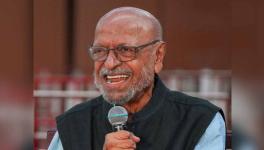Media, Politics and the Sushant Singh Saga
Image for representational use only.
Frenzied media coverage and the zealous actions of the Bharatiya Janata Party-led Central government following the untimely death of film star Sushant Singh Rajput on June 14 in Mumbai gives one the impression that this is the only momentous development in the country today. Even if one concedes that the demise of the 34-year-old popular movie actor from Bihar affected his aficionados nationwide, the reactions that followed were over-the-top.
Quick to encash this tragedy for electoral gains in the upcoming Bihar state elections, the Central government unleashed a host of Central investigative agencies to probe the purported role of his actor girlfriend Rhea Chakraborty in his alleged suicide. Barring the Narcotics Control Bureau’s (NCB) rickety charges of drug dealing against Rhea, the Central Bureau of Investigation (CBI) and Enforcement Directorate (ED) appear to have drawn a blank on the so-called murder and money laundering accusations. Yet, with Rhea’s arrest for drug-related activities, vigilantes in the mass media and society are gloating over their initial victory.
Though limited, several enlightened citizens have decried the macabre media trial of Rhea Chakraborty. Likewise, viewing the ongoing controversy in the context of fraught Centre-state relations, they realise that the BJP-led Central government is exploiting Sushant Singh’s death to discredit the Maha Vikas Aghadi (MVA) government in Maharashtra headed by the Shiv Sena.
That the Supreme Court, through its verdict, has legitimised the Centre’s unwarranted foray into Maharashtra’s administration, has also raised eyebrows in legal circles. From the initial alleged murder investigation, the Sushant Singh case has now whittled down to a gossamer drug-related charge, an irony that has not escaped critical attention.
Thus, at several levels, the death of a film star holds a mirror to the grotesque aberrations of our polity and society. But this is not all. There is more to the case than political one-upmanship, institutional decay, and the heartless hounding of Rhea Chakraborty. The Sushant Singh saga points to at least five foundational lacunae in our institutional arrangements and social values.
First, for someone coming from a nondescript background in Bihar, Sushant’s achievements were enviable. Within a short period, he transitioned from TV soaps to films and enjoyed a modicum of success. By all accounts, he earned handsomely and was an up-and-coming actor. Yet, as often happens, he could not negotiate the challenges that come with success. Achievements, fame, and prosperity often lead to the loss of strategic focus. Besides, access to plentiful resources makes one prone to excesses.
The upshot is success becomes one’s nemesis. At its roots lies the mistaken notion that the biggest challenge is being successful. Everything else can be easily managed. As was proven in Sushant’s case, nothing can be more deceptive than the fleeting charm of success.
Second, the unedifying circumstances leading to Sushant Singh’s death and the more obnoxious responses they triggered – the vicious demonising of Rhea, slut shaming, attributing motives, and so on – were not adventitious.
Two forces were at play. First, several sections of the visual media launched a vitriolic slander campaign against Rhea, accusing her – without an iota of evidence - of everything from performing black magic to willfully poisoning Sushant.
Second, equally egregious, was the eagerness with which most viewers seemed to revel in this lurid sensationalism. TV channels wanted to boost their TRPs and ingratiate themselves with the BJP. Lay viewers were content with scurrilous titillation. No one seemed to care about reputations, privacy, and elementary human decency.
This level of depravity points to a bankruptcy of values. As a society, we tend to valorise hyper consumerism, mindless hedonism, trivial pursuits, ego focality, and a get-rich-quick culture. Myopic, market-driven values have perverted our sense of priorities. Without abiding goals, a sense of purpose, and a commitment to promote the common weal, we flounder aimlessly in a moral void. This is the backdrop in which social pathologies occur. We must, therefore, revamp our moth-eaten culture and address the urgent task of institutionalising life-enhancing values. This exercise is too important to be outsourced to pontificating religious leaders; it can be accomplished only through dialogue, debates, and education.
Third, Sushant’s death has focused attention on the dysfunctional nature of the so-called ‘film industry.’ This entity does not have any trappings of a well-organised, professional ‘industry.’ Instead, reports suggest the underworld and those with black money are major players in this field.
The film ‘industry’ is known for being clannish, misogynistic, and oppressive. It operates through patron-client networks. Hence, most often, knowing someone powerful matters more than one’s acting skills. Newcomers are thus forced to ‘cultivate’ a patron and quickly fit into the sleazy culture of the film ‘industry.’ Anxiety is writ large in this enterprise.
Yet, in the Indian context, the insecurity is so insane that it often drives people to substance abuse. Sushant Singh himself was reportedly a victim of these dark forces and is said to have taken to drugs. According to insiders, this is a common phenomenon. However, the ‘industry’ offers no counseling or rehabilitation facilities. To compound matters, it routinely ill-treats and underpays those at the lower echelons. No government has shown any inclination to properly regulate the anarchic film ‘industry.’
Fourth, the investigation into Sushant’s death threw up details of his struggle with depression, anxiety, and bipolar mood disorder. Two aspects of his mental health are vital. First, reports suggest he was diagnosed as early as 2013 and received treatment intermittently. Fearful of being stigmatised, for seven years, he reportedly hid this from everyone, except his close family. Second, reports suggest that neither he nor those close to him knew how to manage his ailments. His sister, reportedly, got him psychotropic drugs illicitly without consulting a psychiatrist.
These facts are not unique to Sushant’s case. They underscore our ostrich-like attitude to mental health. We view mental illness as a curse and the patient is shunned or pitied. Distressingly, India has one of the world’s most woefully inadequate mental health facilities. Ameliorating this situation begins with talking openly about mental health issues, seeing these as any other affliction. Most important, most mental illnesses can be treated or at least efficiently managed with proper care.
Fifth, in the aftermath of Sushant’s death, we have been forced to confront our lack of rudimentary civic and legal sensibilities. We convicted Rhea Chakraborty even before the investigation was complete, disregarding the idea that an accused is deemed innocent until convicted by a court.
Such anomalies arise from a deeply flawed social imaginary, something that includes our moral beliefs and perceptions which make them seem benign and natural. Our moral imaginary – comprising our socially learned notions of what is good and how someone should be treated - is misshapen and malformed. Together, our warped social and moral imaginaries preclude us from recognising the personhood and dignity of those we see as deviants.
This long-term project cannot be accomplished overnight. However, in the immediate context, we can take several concrete steps to obviate such ethical quagmires.
The first item on the agenda should demand affordable, quality education for all. Unlike the newly announced National Education Policy, which emphasises vocational education and aims to prepare the youth for low-end jobs, our vision of education must prioritise four core principles: human dignity, human security, human development, and civic values, such as tolerance, inclusion, ability to relate to difference, and human rights for all.
This agenda requires massive investment in education. We must stop pretending we can offer world-class education in ramshackle schools run by poorly paid teachers. Besides, we cannot improve education by continuing to ignore rural hinterlands and small towns.
Another powerful initiative requires boycotting TV channels, films, and film personalities involved in unscrupulous practices, such as the sexual harassment of women, violating laws, and flouting basic canons of decency. Leveraging social media, civil society groups should create awareness, expose wrongdoers, and ensure they don’t endlessly profit from their misdeeds. What we need is ‘Me-Too 2.0,’ an expanded version of the ‘Me-Too’ movement embracing all forms of social indignities.
If we remain indifferent or expect someone else to shoulder social responsibilities, we will have to deal with two consequences. First, the coarsening of our collective lives and the resulting breakdown of social norms will soon be beyond redemption.
Second, governments and elites will capitalise on the disarray to further their agenda. It is hard to think of more compelling reasons to redress our current situation. Doing so will also ensure Sushant’s death was not in vain.
The writer teaches Sociology and Asian Studies at Kettering University in Flint, Michigan, in the US. He is also a practicing attorney in the United States. The views are personal.
Get the latest reports & analysis with people's perspective on Protests, movements & deep analytical videos, discussions of the current affairs in your Telegram app. Subscribe to NewsClick's Telegram channel & get Real-Time updates on stories, as they get published on our website.
























